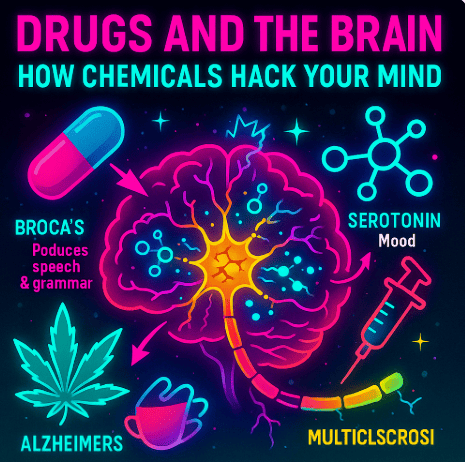
In Lesson 4, we saw how neurons can fail—strokes cut off oxygen, epilepsy creates electrical storms, Alzheimer’s tangles memories, Parkinson’s slows movement, and multiple sclerosis strips away myelin.
We learned that the brain is fragile but not hopeless—science is finding ways to repair and adapt.
Now let’s turn to something very different: what happens when chemicals from outside the body – drugs – interfere with the brain’s chemistry?
Sometimes this is good (like medicines). Sometimes it’s dangerous (like addictive substances).
Either way, drugs hack the brain’s messaging system.
Step 1: Drugs Are Brain Mimics 🪞
Drugs work because they look like neurotransmitters or change how neurotransmitters behave.
👉 Remember: neurotransmitters are the brain’s mail system. Drugs sneak into this system and either:
-
Pretend to be a neurotransmitter.
-
Block a neurotransmitter.
-
Boost a neurotransmitter.
-
Stop cleanup so the message keeps going.
It’s like a trickster slipping letters into your mailbox, or stealing old letters so the signal never ends.
Step 2: Medicines vs. Addictive Drugs ⚖️
Not all drugs are bad. Many are life-saving medicines.
But the line between healing and harm is often about dose, purpose, and control.
-
Medicines (like antidepressants, painkillers, or ADHD drugs) are carefully designed and controlled.
-
Addictive drugs (like cocaine, heroin, or methamphetamine) overwhelm the brain’s natural systems, causing artificial highs but also dangerous rewiring.
The brain doesn’t care if a chemical came from a doctor’s prescription or from the street – it only cares about how that chemical affects neurotransmitters.
Step 3: How Different Drugs Hack the Brain 🧩
1. Cocaine and Amphetamines – Dopamine Flood 💦
-
These block reuptake of dopamine, keeping it in the synapse.
-
The result: huge waves of pleasure and reward.
-
But the brain adapts, reducing its own dopamine. Over time, normal life feels dull without the drug.
👉 Analogy: Imagine every time you ate ice cream, someone forced you to eat 100 scoops at once. At first it’s thrilling. Soon, your brain gets tired and ice cream stops feeling special.
2. Opioids (Heroin, Morphine, Prescription Painkillers) – Endorphin Hijack 😌
-
These drugs mimic endorphins, the body’s natural painkillers.
-
They bind to receptors that reduce pain and create calm euphoria.
-
The danger: tolerance builds quickly, and stopping causes painful withdrawal.
👉 Analogy: Endorphins are like your body’s gentle lullaby. Opioids blast it on giant speakers until the natural lullaby can’t be heard anymore.
3. Nicotine – Acetylcholine’s Impostor 🚬
-
Nicotine mimics acetylcholine, which controls attention and alertness.
-
It makes neurons release more dopamine too—so smoking is both focusing and rewarding.
-
But addiction forms fast, because the brain rewires around nicotine.
4. Alcohol – The GABA Booster 🍷
-
Alcohol increases GABA (the calming messenger) and decreases glutamate (the excitatory one).
-
That’s why small amounts make people relaxed, but large amounts cause slurred speech, loss of control, and blackouts.
👉 Alcohol is like turning down the volume on the brain’s orchestra—at first it feels calm, but too much and the music becomes chaotic.
5. Cannabis (Marijuana) – The THC Trick 🌿
-
THC mimics natural brain messengers called endocannabinoids.
-
These normally regulate mood, appetite, and perception of time.
-
Cannabis alters these, causing relaxation, euphoria, but also memory and coordination problems.
6. Caffeine – The Adenosine Blocker ☕
-
Adenosine is a neurotransmitter that makes you sleepy.
-
Caffeine blocks adenosine receptors, so you stay alert.
-
But it doesn’t create energy—it just stops your brain from realizing it’s tired.
Step 4: Addiction – The Brain Gets Rewired 🔄
Why do some drugs cause addiction? Because they target the brain’s reward system—especially dopamine pathways in the nucleus accumbens.
Addictive drugs “teach” the brain that the drug is the most important thing. Over time:
-
The brain reduces natural dopamine release.
-
Everyday pleasures (food, friends, hobbies) feel less rewarding.
-
The person craves the drug just to feel “normal.”
👉 This is why addiction is not just a bad habit—it’s a brain disorder where reward wiring is hijacked.
Step 5: Healing the Brain 💊🌱
Not all is hopeless. The brain can heal:
-
Medicines can help rebalance neurotransmitters.
-
Therapies (like cognitive behavioral therapy) help retrain thought patterns.
-
Neuroplasticity allows circuits to recover with time and effort.
The challenge is that addiction rewires strong habits, so recovery often needs patience, support, and sometimes lifelong care.